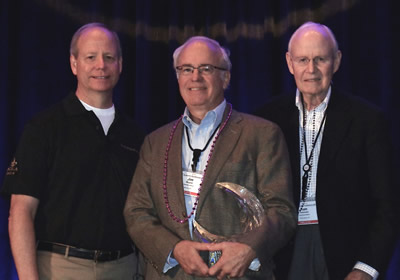Command Alkon capped its 2014 Customer Training and Technology Conference general session recognizing Jim Wagner, who is retiring from his longtime post as vice president, and shifting to consulting assignments that will keep him engaged with COMMANDseries users.
Few, if any, have observed as closely the evolution of ready mixed concrete order dispatching and mixer fleet tracking as Wagner. He has seen the industry progress from communication via crackling radios and signaling devices relying on spectrum no longer public to today’s GPS and mobile communications tools.
“I tell people that Steve Jobs and Bill Gates are not only ones who started computer businesses out of their garages,” says Wagner, reflecting on Advanced Control Systems (ACS), which he founded in 1973 with backing from a colleague, Syd Reed, sales manager at Minnesota’s J.L. Shiely Co. After leaving the integrated ready mixed and aggregate producer—where he held dispatcher, sales and quality control positions—Wagner pursued construction materials fleet tracking and dispatching solutions using early Intel microprocessor-powered equipment, along with Apple I & II and Digital Equipment computers.
Flanked by Command Alkon colleagues of 20-plus years, CEO Phil Ramsey (left) and Executive Chairman Ken Robinson, Jim Wagner was honored during the conference opener, the send off message: He is retiring to consulting. In addition to his Command Alkon tenure, Wagner is a longtime instructor for the NRMCA Management of Materials Dispatch course, and author of “The Handbook of Ready-Mixed Concrete Dispatching.” |
Computing possibilities emanating from those brands informed ACS’ envisioning of automated alternatives to 1960s and early-1970s construction materials fleet dispatching methods or magnetic devices, from the crude to the near-comical: a) manual truck scheduling on graph paper; b) clock-driven displays with vehicle travel or site times measured in five-minute increment arcs and magnets representing trucks; c) Robert Shiely’s horizontal tracking board, with rubber belts moving right to left, one inch in five minutes, across estimated “to job” and “on job” and “to plant” sections; or, d) the operations monitor, a horizontal board with truck magnets crossing stainless steel strips and designated loading, site and travel intervals.
Marked improvements in computer storage capacity and processing power, along with fast document and ticket printing capability, put ACS on a course toward a 1985 merger with a Command Data, a Birmingham, Ala., construction materials business accounting software developer. For Wagner, nearly three decades of dispatching, scheduling and fleet tracking product development and launches were at hand.
The merger was pivotal to a business that would emerge as the information technology leader for concrete and bulk materials producers. ACS/Command Data acquired Eagle computerized batching system developer, Dallas-based Precision Systems Inc., in 1987. With competencies in batching controls, plus dispatching and accounting information technology, PSI/Command Data was positioned to develop software exploiting increasingly powerful computers. Eagle/PSI brought additional ready mixed producers to whom Wagner and his colleagues could present advanced truck dispatching methods and tools. Market presence built in the early- to mid-1990s enabled Command Data to lead a 1998 merger with Alkon Corp., solidifying the Command Alkon flagship.
